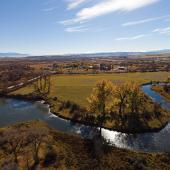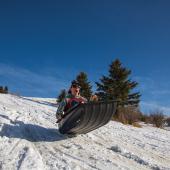Relaxing Challenge
In New Mexico, it's 100 degrees out in July and the last thing you want to do is walk around with 20 pounds of golf clubs on your back for four hours. But that's what I did summer after summer as a kid, because my parents kept signing me up for lessons and tournaments. I wore golf's scarlet letter—a pale left hand, unknown to the sun because of my glove. It was hard to look forward to playing golf then, because a 10-year-old with a mean chip shot and mismatched hands isn't exactly the most popular kid on the block. But by my mid-20s I appreciated the lifetime gift I had been given.
A lot of people say, "How hard can golf be?" Well, hard! Becoming a decent golfer requires skill, consistency, focus, and a heck of a lot of practice. Like skiing, a lot of people don't pick it up easily on the first try. You have to coordinate your knees, hips, arms, shoulders, and head in every swing, and the repetitive motion can even cause shoulder and back injuries. Obviously, golf is not as physically strenuous as running a marathon, but it improves your flexibility, agility, and coordination. And lugging 20 pounds around on your back for four hours isn't something to just dismiss.
Golf is as mental as it is physical. A golfer must proficiently estimate necessary distances and physical force, but more importantly he or she must create muscle memory—the ability to precisely move a dozen body parts consistently to give the ball a desired loft or distance. Achieving consistency is a big deal in golf, and most players spend their whole lives working toward this goal. That's why one of the biggest mental challenges (which, once mastered, helps tremendously in life) is learning to suppress negative thoughts, because a golfer's performance is also psychosomatic. Common examples of this are the "first-tee jitters" or the "yips," where the player is worried about flubbing a shot and looking like an incompetent doofus. The worry increases the heart rate and causes jerky muscles, ruining the shot and creating a self-fulfilling prophecy. As in life, it's important (and difficult) to believe in your abilities after making bad shots.
How then can golf be relaxing like so many people say? Well, a friend once told me that doing a 5.9 climb was one of his favorite ways to relax because he had to focus so intensely on not falling that his problems involuntarily left his mind. Golf is similar: It's nearly impossible to hit the ball well and think about your taxes at the same time.
Once in a while someone regurgitates the tired complaint that golf is expensive and elitist. The truth is, golf is for everyone and there's no reason to feel intimidated. After all, as P. J. O'Rourke says, "Golf combines two favorite American pastimes: taking long walks and hitting things with a stick." Golf is cheap in Montana: a round at Bridger Creek costs less than a Bridger Bowl lift ticket. You don't even have to own clubs—every local public course we called rents clubs, and Gallatin Valley Golf in Belgrade actually lends them for free.
Like other sports, golf is sustained by attracting all kinds of enthusiasts. There are the Caddyshack lovers (like me), who purposely wear plaid pants and say "niblick" as often as possible. There are the meditators, who enjoy the smell of the grass and like to watch the geese patrol the fairways in one of the few places left where being quiet is required. And there are the junkies, who plan weddings around the Masters, always travel with their clubs, and enjoy discussing the physical qualities of graphite.
Don't knock golf till you try it. As Sports Illustrated writer Rick Reilly puts it, "Golf is the cruelest game, because eventually it will drag you out in front of the whole school, take your lunch money and slap you around."











